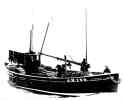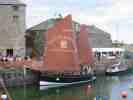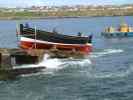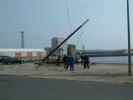 | Caithness.Org | Community | Business | Entertainment | Caithness... | Tourist Info | Site Map |
• Advertising • Chat Room • Contact Us • Kids Links • Links • Messageboard • News - Local & Scottish • News - UK & News Links • About / Contact Us • Submissions |
• Bookshop • Business Index & News • Jobs • Property For Sale • Property For Rent • Shop • Sutherland Business Index |
• Fishing • Fun Stuff • George, The Saga • Horses • Local Galas • Music • Pub Guide • Sport Index • What's On In Caithness |
• General Information • B & Bs • Backpackers • Caravan & Camping • Ferries • Getting Here • Holiday Letting • Hotels • Orkney • Pentland Firth • Sutherland • Taxis |
| N E W S F E E D S >>> |
|
Isabella Fortuna WK499 |
|
History Of The Isabella Fortuna
|
Pictures &
Other Information
Wick
Harbourfest 2007
At Portsoy 8 July 06 The 2007 Flotilla From
Wick AH 153 Previous Registration at Arbroath |
|
Herring were caught by drift netting. In this method of fishing a long curtain of nets are cast or �shot� from the boat in a continuous line. This was done at night because herring swim close to the surface in the dark. The best time is just after sunset or just before dawn. Once the nets are set the boat�s head is turned into the wind and the foremast is lowered back onto its crutch. From the mid 1890�s on many of the bigger boats were fitted with a steam winch to help with this and to haul in the nets. With the foremast lowered the boat was then allowed to drift with the tide for three to four hours or until the skipper�s own experience told him it was time to make a haul. �Isabella� had a 15 h.p. Kelvin auxiliary engine fitted in 1919. In seine net fishing an anchor with a marker buoy attached was put overboard. The boat then sailed a triangular course playing out first one then the net then completing the triangle to sail back to the marker buoy. It then picked up the anchor and hauled the net in against the flow of the tide. In April 1928 Alex, James and John joined their father and together they installed a new Kelvin K2 44 p. engine. They also gave their boat a new name �Fortuna�. Many people think it is unlucky to change a boat�s name. This superstition is not shared with fishermen. For the rest of her working life �Fortuna� was used for line and seine net fishing. One August day in 1976 the fishing boat �Fortuna� slipped quietly into Tayport harbour. On board were Alex, James and John Smith, the three brothers who owned her. The �Fortuna had been built for and worked by the same Arbroath family for 86 years and the brothers had decided that it was time to retire from the sea. 1976 - 1997 Hobson Rankin had originally intended to keep her as a traditional Scottish motor fishing boat. But when he discovered her history he began the long task of restoring her original lug� sail rig. The first problem was acquiring suitable masts, which are substantial pieces of timber for a vessel of this size. The fore mast is 43� long and the mizzen 35�. The original main mast was got second hand from Gerrard�s boatyard in Arbroath. It was later replaced with a Douglas fir specially selected and felled from the St. Fort estate in Fife. The mizzen mast and 30� long bowsprit were formed from telegraph poles Hobson hand sewed her three sails from 14 ounce cotton canvas. Together they gave hen spread of 1330 square feet of sail. Restoration took four years of hard work and on September 19, 1980, she was renamed �Isabella Fortuna�.
Wick Society Acquires The Boat Society members designed and built a steel cradle to enable the Isabella Fortuna to be hauled into the Old Lifeboat Shed. The cradle was constructed from steel from an old radio mast, which had been dismantled. This steel was gifted by Hugh Simpson. Contractors Wick A survey of the boat was done by Ken Sutherland a local boat builder and it was recommended that the deck to be removed as it was rotten. When this task was completed it was found that all the deck beams and top of the frames were also rotten so they had to be removed also. So as the frames were being removed they were replaced with 110 new oak frames as work went along to retain the shape of the hull. The deck stringers were also replaced and new deck beams, which were donated by Messrs A Murray, Pitch Pine and Oregon Pine from a radar tower dismantled in 1948, J Oag from Scarclet, Pitch Pine from an old railway bridge, J. Mackay from Forse Dounreay, Red Pine log from the American Base Forse after all the new frames were replaced. The forward and aft aprons were replaced with elm from Mr Mackey from Berridale. Slabs of the Oak, Larch and ash were purchased from Mr D Sutherland Sawmills Wick. The men at the sawmill cut the frames to shapes, mostly in their own time, which in turn was a saving to the Society. The rotten planks were then removed and replaced with Larch. Additional wood was purchased from Muir of Ord sawmills. The commons for the forward, aft hatches and the hold were also renewed, using what wood was available. New bulkheads then were put in the aft bulkhead was put a frame forward to give more room in the engine-room were made from the cuttings of all the woods available. The new deck of Douglas Fir (2 inches thick) was then laid and caulked with oakum and hot bitumen. The oak frames, uprights were trimmed at rail height, and the new rail made from Oroko, purchased from D Sutherland Sawmills Wick, was fitted. The accommodation in the fore peak and the hold was then replaced and the fire installed. The main sail was found to be ripe and Pultneney Distillers kindly sponsored a new main sail especially made by sail-makers in Essex. Three planks had to be cut out and replaced two on the port side and one on the starboard side. The large one under the bilge keel on the port side was replaced by Ken Sutherland who did the original survey. Every nail on the hull had to be checked and over 600 four inch galvanised cut nails had to be replaced. All the chalking was checked, replaced, and filled. This was a big task, as part of the boat sustained damage, which had disturbed the chalking and fillers, The two bilge keels had to removed as the starboard side bilge keel was badly damaged as this was the side that took the weight when she fell over in the abortive launch. The port side bilge was also replaced, using oak purchased from Dingwall sawmill. The slab of oak was 60 mm thicker, and the bilge keels were made 500mm longer, for added strength. This work was undertaken by Adam Polson a qualified boat builder, assisted by Kevin MacAlpine. This work was carried out at nights and weekends. Large galvanised bolts were used to secure the Bilge Keels through the oak frames; these bolts were gifted from Scottish Hydro Board. The oak frames which the engine was bolted to was strengthened and addition steel supports were bolts through. This steel was then covered in reinforced concrete to add support to the engine mountings. This was on advice given by Adam Polson. The Kelvin K3 engine was totally overhauled, all new shell bearings, trust bearings in the gear box, piston rings and valves were installed by J Bruce and D Rosie experienced engineers who first worked on these engines in their apprenticeship. A new propeller shaft was supplied by UKAEA Dounreay. This was machined free of charge by Simrad at Wick Industrial Estate and fitted by said engineers. The bilges were totally cleaned out, and painted. The hold area was totally re- designed, by Adam Miller, and new flooring was installed. The hull was given 4 coats of paint and the steel keel shoe painted with� Red Lead� primer prior to launching. She was re-launched in May 1999 and she made trips to Eyemouth near Berwick, and Portsoy that year. The Isabella Fortuna was then re-slipped back into the lifeboat shed for the winter for maintenance and annual re-paint. During the re-launched in May 2000, the Isabella Fortuna she came out of her cradle fell on to the slipway and sustained extensive damage to parts of the hull. When the call for volunteers came a total of 24 men came to the rescue of the Isabella Fortuna. Heavy lifting wires, slings, and various pieces of equipment was given by Hugh Simpson, Contractors. Jock Bissett, aged 79, came down to offer help, and quickly suggested how to pull the boat up the slipway. Large slings were placed around the hull; a heavy wire joined the slings, which was then attached to the main haulage wire. Before the winch was engaged to pull, all personnel were placed safely away fro any danger. On the first pull, the boat moved approximately 6 metres, wood was placed between the boat and the concrete slip, to try to minimise damage. During the second pull, the boat started to move back on to the cradle, which made the task a bit easier to control. This method continued until the vessel was up past the high water mark, making it safe. The task of pulling the boat started at 1930 hours; by 2330 the boat was back in the lifeboat shed, which was a big relief to all the workers. It was decided the next day to survey the damage, and at the suggestion of members that the running of the �Isabella Fortuna� was then taken over by a subcommittee called �The Boat Committee� to oversee the repairs and the running of the vessel The interior of the hold had to be removed to gain access to the damage. The broken frames 11 in number
replaced with oak in the hold and engine room. Also a lot of the frames
had to be drilled and bolted. More than 50 of these bolts were gifted by
Hydro Board, Launching The Second Time Around Mr John McSween, an engineer from Henry Abrum & son of Glasgow designed the new launching system, which used a series of blocks and wires. The anchor points were drilled and grouted (Tony & Malcolm) and a test using rope to make sure that the positions of the Pulleys / Blocks were correct. All parts and equipment was labelled to ensure that no mix up would take place. The system was tested a few weeks before the launch. A method statement and risk assessments were prepared. The pilot boat was to attach a tow rope to the vessel, this rope was taken to the pilot boat using a small work boat (William Crowe) The Cradle was lowered down the slipway, to a point where the cradle was made fast to a strong point. The main haulage wire was disconnected, and attached to the snatch wire. The other end of the snatch wire was attached to the outward end of the boats cradle. The main wire was hauled up very slowly, until the snatch wire became tight. At this point the Pilot boat went into position, the Aft Bilge blocks on the cradle were removed. A final check was made on shore side (Malcolm Bremner) Persons on Board the Isabella Fortuna for launching were Tony Sinclair (in charge) J Bruce, (engineer) Kevin McAlipine and Norman MacLeod, who was to watch out for any problems which he would radio to shore. After safety check, the winch, operated by Don Rosie (engineer and winch man with RNLI) pulled main wire slowly, the holding rope was released and the boat moved down the slipway. This operation went very well, and the launch, for the first time was controlled, and could be stopped at any time, without any danger. The Isabella Fortuna was then launched at the highest tide in May 2003. The repair work proved successful to the extent that the vessel came into the harbour under her own power. J Bruce started the engine, which had not been run for 2 years, and was totally overhauled. Weather conditions on the day were so good that two hours from the launch a trip around the bay was organised. Members of the Society and wives enjoyed the trip, and it was suggested that further trips be made later in the summer. Mast Problems Safety Work and maintenance is ongoing, also the requirements to install safety deck rails and a fire suppression system for the engine room to bring her up to standard t0o carry passengers. In 2004 The Wick Society had to update its constitution to modern standards and also became a limited company to meet these standards. With this change �The Boat Committee� had its own directors and committee to take over the complete running of all boats belonging to the society The Future For the Last Fifie |














